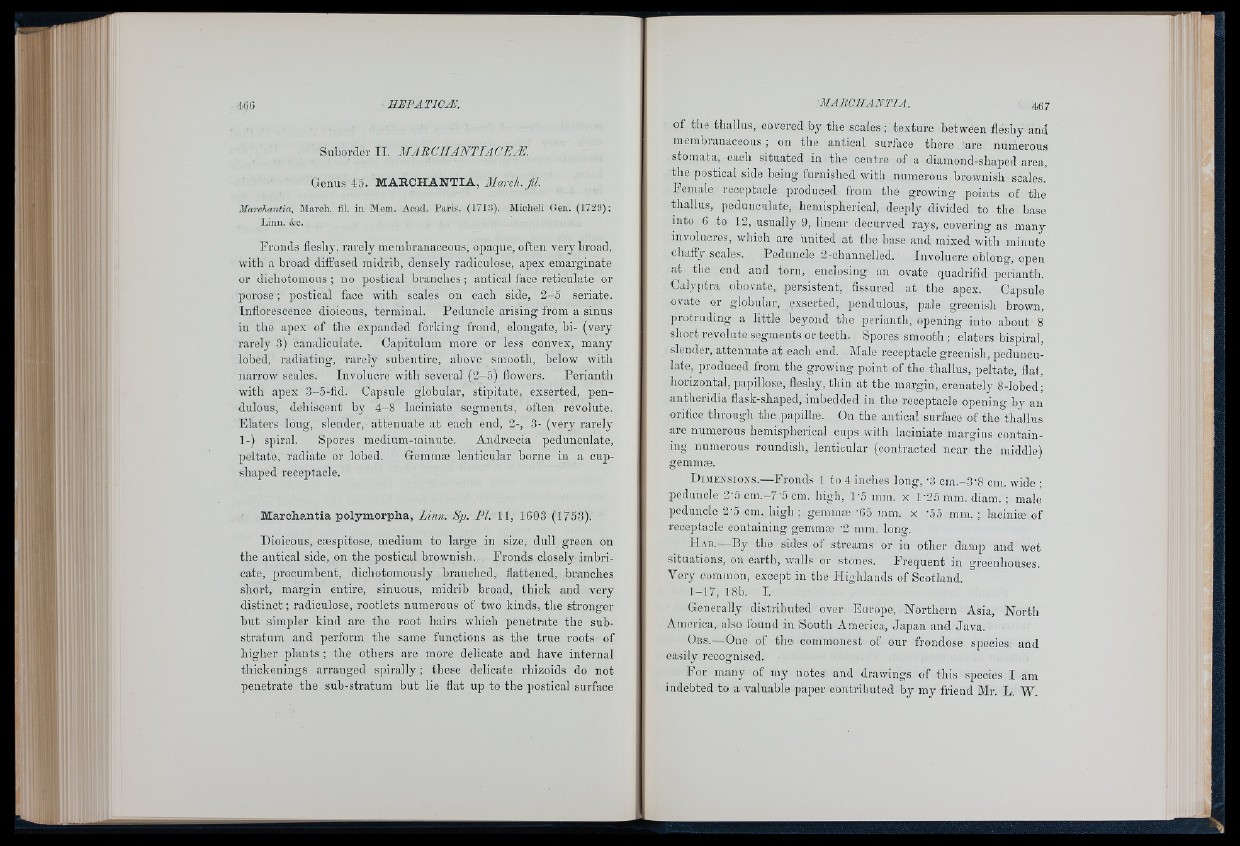
! /
Suborder II. MABC1IANTIACEÆ.
Genus 45. MARCHANTIA, March, fil.
ilarchantia, March, fil. in Mem. Acad. Paris. (1713). Micheli Gen. (1729);
Linn. Ac.
Fronds flesbi', rarely membranaoeous, opaque, often veiy broad,
witli a broad difitisecl midrib, densely radiculose, aqiex emarginate
or dichotomous; no postical branches; antical face reticulate or
porose ; jiostioal face with scales on each side, 2-5 seriate.
Inflorescence dioicous, terminal. Peduncle arising from a sinus
in the apex of the expanded forking frond, elongate, bi- (very
rarely 3) canaliculate. Capitulum more or less convex, many
lobed, radiating, rarely subentire, above smooth, below with
narrow scales. Involucre with several (2-5) flowers. Perianth
with apex 3-5-hd. Capsule globular, stipitate, exserted, pendulous,
dehiscent by 4—8 laciniate segments, often revolute.
Elaters long, slender, attenuate at each end, 2-, 3- (very rarely
1-) spiral. Spores medium-minute. Androecia pedunculate,
peltate, radiate or lobed. Gemmæ lenticular borne in a cupshaped
receptacle.
Marchantía polymorpha, Linn. Sp. Fl. 11, 1603 (1753).
Dioicous, cæspitose, medium to large in size, dull green on
the antical side, on the postical brownish. Fronds closely imbricate,
procumbent, dichotomously branched, flattened, branches
short, margin entire, sinuous, midrib broad, thick and very
distinct ; radiculose, rootlets numerous of two kinds, the stronger
but simpler kind are the root hairs which penetrate the substratum
and perform the same functions as the true roots of
higher plants ; the others are more delicate and have internal
thickenings arranged spirally ; these delicate rhizoids do not
penetrate the sub-stratum but lie flat up to the postical surface
of the thallus, covered by the scales ; texture between fleshy and
membranaceous ; on the antical surface there are numerous
stomata, each situated in the centre of a diamond-shaped area,
the postical side being furnished witli numerous browni.sh .scales.
Female receptacle produced from tlie growing points of the
thallus, pedunculate, hemispherical, deeply divided to the base
nito 6 to 12, usually 9, linear deeurved rays, covering as many
involucres, which are united at the base and mixed with minute
chafty scales. Peduncle 2-ohannellecl. Involucre oblong, open
at the end and torn, enclosing an ovate quadrifid perianth.
Calyptra obovate, persistent, fissured at the apex. Capsule
ovate or globular, exserted, pendulous, pale greenish brown,
protruding a little beyond the perianth, opening into about 8
short revoluto segments or teeth. Spores smooth; elaters bispiral,
.slender, attenuate at each end. Male receptacle greenish, pedunculate,
produced from the growing point of the thallus, peltate, flat,
horizontal, papillose, fleshy, thin at the margin, orenately 8-lobed;
antheridia flask-shaped, imbedded in the receptacle opening by an
orifice through the papillæ. On the antical surface of the thallus
are numerous hemispherical cups with laciniate margins containing
numerous roundish, lenticular (contracted near the middle)
gemmæ.
D imensions.—Pronds 1 to 4 inches long, '3 orn.-3'8 cm. wide ;
peduncle 2-5 cm.-7-5 cm. high, 1'5 mm. x 1'25 mm. diam. ; male
qioduuclo 2-5 ora. high; gemmæ '65 mm. x -55 mm. ; laciniæ of
receptacle containing gemmæ ’2 mm. long.
H ab.—By the sides ot streams or in other damp and wet
situations, on earth, walls or stones. Frequent in greenhouses.
Very oorainon, except in the Highlands of Scotland.
1-17, 18b. I.
Generally distributed over Europe, Northern Asia, North
America, also found in South America, Japan and Java.
Oiis.—One of the commonest of our frondose species and
easily recognised.
For many of my notes and drawings of this species I am
indebted to a valuable pajrer contributed by my friend Mr. L. W.